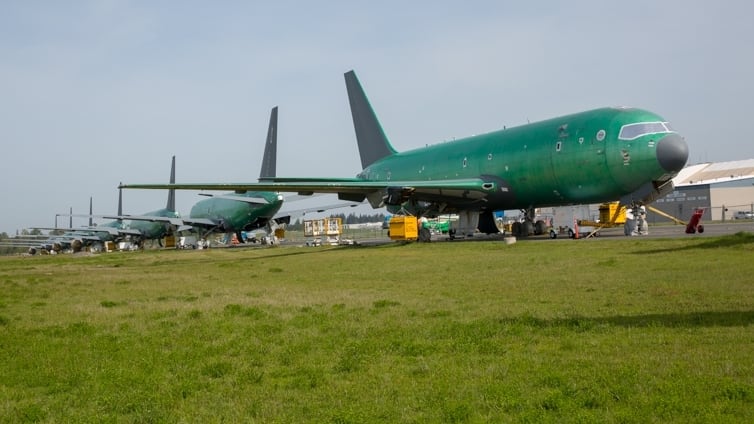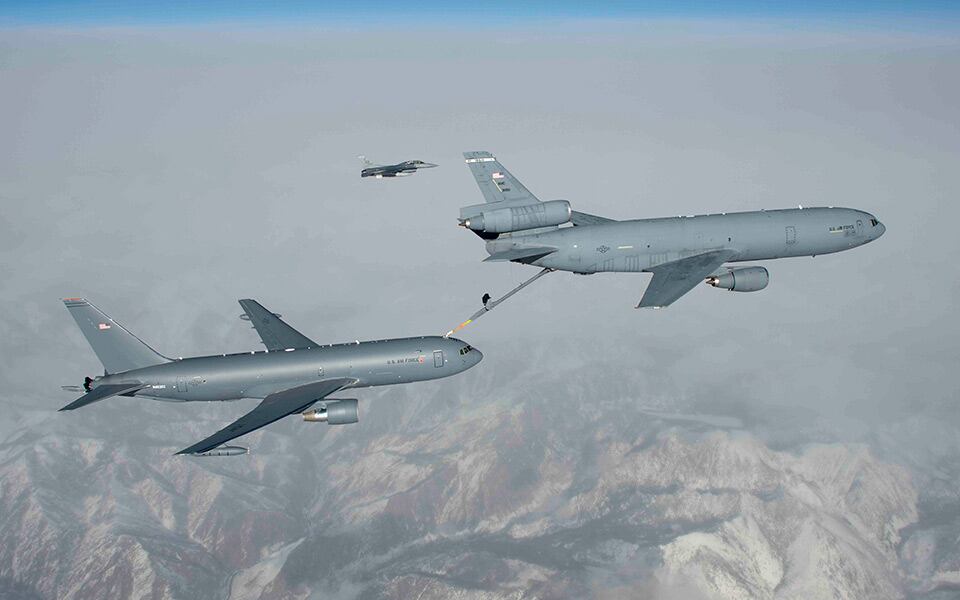WASHINGTON — In a move that could have major impacts on the already-delayed tanker program, the U.S. Air Force has indefinitely barred the KC-46 from carrying cargo and passengers, Defense News has learned.
The decision was made after an incident occurred where the cargo locks on the bottom of the floor of the aircraft became unlocked during a recent flight, creating concerns that airmen could potentially be hurt or even killed by heavy equipment that suddenly bursts free during a flight.
“As a result of this discovery, the Air Force has submitted a Category 1 deficiency report and is working with Boeing to identify a solution,” Air Force Mobility Command spokesman Col. Damien Pickart said in a statement. The service uses the term Category 1 to describe serious technical issues that could endanger the aircrew and aircraft or have other major effects.
“Until we find a viable solution with Boeing to remedy this problem, we can’t jeopardize the safety of our aircrew and this aircraft,” he said.
RELATED

The problem was discovered during a recent overseas operational test and evaluation flight, when KC-46 aircrew noticed that numerous cargo restraint devices had come unlocked over the course of the multiple legs of the trip.
“Prior to departing for each of these missions, aircrew fully installed, locked and thoroughly inspected each restraint, and performed routine inspections of the restraints in flight,” Pickart said. “Despite these safety measures, the unlocking of cargo floor restraints occurred during flight, although no cargo or equipment moved and there was no specific risk to the aircraft or crew.”
A source with knowledge of the issue told Defense News that if all restraints on a particular pallet had become unlocked, it would be able to roll freely throughout the cabin. If all cargo became unlatched, it could pose a safety risk to aircrew or even unbalance the aircraft — making the plane “difficult, if not impossible” to control.
While this problem has only been observed on one KC-46, the Air Force does not have enough information to rule out other aircraft having a similar defect.
The problem also poses a danger to the tanker’s operational test schedule, Pickart said. The program was set to start initial operational test and evaluation this fall, with pre-IOT&E activities already initiated.
“This is a multi-mission aircraft, it’s for carrying cargo and passengers, it’s for refueling and also the aeromedical evacuation mission,” he said. “If you can’t carry cargo pallets and patient litters, a significant amount of your core missions cannot be properly tested.”
In a statement, KC-46 manufacturer Boeing acknowledged that it had been notified of the new issue.
“The company and the Air Force are cooperatively analyzing the locks to determine a root cause,” Boeing stated. “The safety of KC-46 aircraft and crew is our top priority. Once a cause has been identified, the tanker team will implement any required actions as quickly as possible.”
But the problem could be bad news for Boeing’s bottom line. The company is locked into a fixed-price contract for where it is responsible for paying for any expenses beyond the initial $4.9 billion award for development of the aircraft. So far, the company has paid more than $3.5 billion of its own money to fund corrections to ongoing technical issues.
RELATED

The latest Cat-1 deficiency brings the total up to four:
- The tanker’s remote vision system or RVS — the camera system that allows KC-46 boom operators to steer the boom into a receiver aircraft without having to look out a window and use visual cues — provides imagery in certain lighting conditions that appears warped or misleading. Boeing has agreed to pay for potentially extensive hardware and software fixes, but the Air Force believes it will be three or four years until the system is fully functional.
- The Air Force has recorded instances of the boom scraping against the airframe of receiver aircraft. Boeing and the Air Force believe this problem is a symptom of the RVS’s acuity problems and will be eliminated once the camera system is fixed.
- Boeing must redesign the boom to accommodate the A-10, which currently does not generate the thrust necessary to push into the boom for refueling. This problem is a requirements change by the Air Force, which approved Boeing’s design in 2016. Last month, Boeing received a $55.5 million contract to begin work on the new boom actuator.
While the KC-46 program has clocked several key milestones this year, it has also hit some publicly embarrassing stumbles.
After several years of delays, the Air Force finally signed off on the acceptance of the first tanker. However, due to the list of technical problems, Boeing was forced to accept an agreement where the service could withhold up to $28 million per aircraft upon delivery. About $360 million has been withheld so far, Defense One reported in July.
The Air Force plans to buy 179 KC-46s over the life of the program, and 52 are currently on contract. So far, Boeing has delivered 18 tankers to McConnell Air Force Base, Kan.; Altus Air Force Base, Okla; and Pease Air National Guard Base, N.H.
But deliveries were interrupted earlier this year by the discovery of foreign object debris in multiple planes. The Air Force suspended KC-46 flights at Boeing’s production line in Everett, Wash., this February after finding debris. Then it paused all tanker deliveries in March as the service investigated the extent of the problem. The service began accepting tankers again later that month, only for deliveries to stop — and restart — in April due to similar problems.
Will Roper, the service’s acquisition executive, told reporters at the Paris Air Show this July that the service expects to find foreign object debris in KC-46s moving through the line, and it may be months before planes are reliably clean.
“As those airplanes flow forward down the line, we think it’s going to take some time for the new quality assurance inspection processes to start early enough so that airplanes will flow that are FOD-free,” he said, according to Defense One. “It’s not the way we want to get airplanes into the Air Force, but it’s what we’re going to have to do in the meantime.”
This story was corrected on Sept. 12 at 1:50 p.m. EST to include Pease Air National Guard Base.
Valerie Insinna is Defense News' air warfare reporter. She previously worked the Navy/congressional beats for Defense Daily, which followed almost three years as a staff writer for National Defense Magazine. Prior to that, she worked as an editorial assistant for the Tokyo Shimbun’s Washington bureau.








